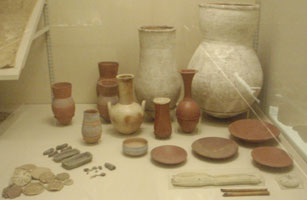KV 54 is little more than a small pit which may in fact be an unfinished shaft of a tomb whose construction was abandoned. It was used as a cache for some of the grave goods and funerary equipment of Tutankhamun because the tomb of Tutankhamun (KV 62) was robbed soon after his burial.
Unlike other caches, KV 54 also contains some of the embalming material from the tomb of Tutankhamun and even some items from the pharaoh’s funerary meal. The cache contained around a dozen sealed storage jars which contained a variety of objects, as well as a supply of natron, pottery, linen, floral wreaths, and animal bones.

An important find from the cache of Tutankhamun was a small piece of linen on which a hieratic text had been drawn which translates as, “The good god, Lord of the Two Lands, Nebkheperure beloved of Min. Linen of year 6″.
Nebkheperure was the prenomen of Tutankhamun, so the text confirmed that there had been a pharaoh with that name and that the goods in the cache were from his tomb.
The cache was discovered by Theodore M. Davis in 1907 shortly after he excavated the tomb of Horemheb (KV 57). Davis thought that he had found the tomb of Tutankhamun and said as much in his book “The Tombs of Harmhabi and Touatankhamanou”.

In 1923, Winlock suggested that KV 54 was not actually the tomb of Tutankhamun, but was in fact an embalming cache containing items left over from the mummification of the pharaoh. This was one clue that the tomb of Tutankhamun was still hidden in the Valley of the Kings somewhere. From his consideration of the food and other items from the funerary banquet Winlock estimated that there had been a total of eight mourners at the funeral.
When the tomb of Tutankhamun was discovered by Carter in 1922, similar items were found in the entrance corridor. Carter suggested that after the first tomb robbery the embalming cache material (which was probably stored in the entrance corridor) was moved to KV 54, and the corridor filled with rocks and debris in the hope that this would prevent any future break-ins.
- Tomb of Tutankhamun
- Tutankhamun
- Tutankhamun cache (KV 54)
- Was Tutankhamun murdered?
- “Curse” of Tutankhamun’s tomb
- Ankhesenpaaten (Ankhesenamun)
- Amarna Royal Family
- Amarna Religion
- Amarna Letters
Bibliography
- Bard, Kathryn (2008) An introduction to the Archaeology of Ancient Egypt
- Reeves, N and Wilkinson, R.H. (1996) The Complete Valley of the Kings
- Siliotti, A (1996) Guide to the Valley of the Kings and to the Theban Necropolises and Temples
- Strudwick, Nigel and Helen (1999) Thebes in Egypt
- Wilkinson, Richard H. (2003) The Complete Gods and Goddesses of Ancient Egypt
- Wilkinson, Richard H. (2000) The Complete Temples of Ancient Egypt
- Wilson, Hilary (1997) People of the Pharaohs
Copyright J Hill 2016